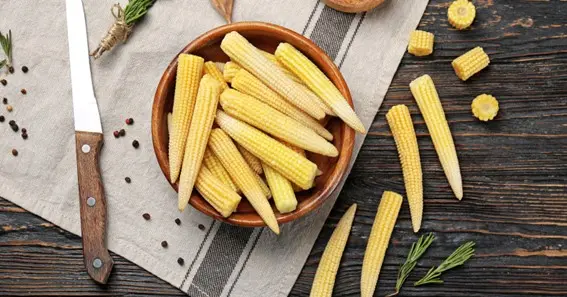What is baby corn? Baby corn is young, immature corn harvested early while the stalks are still small and tender. People adore adding this charming vegetable to salads, stir-fries, and Asian meals. The tiny, crisp vegetable sticks out in any meal. Despite its popularity, fresh baby corn is hard to get in the West. The essay will explain baby corn, how to cook it, its health advantages, and more. In this article, we discuss what is baby corn and more about it.
What Is Baby Corn?
Baby corn is young, immature corn harvested early while the stalks are still small and tender. The stalks of baby corn, commonly known as corvettes, are still little when picked early in the season. Soft and crispy, this small veggie tastes pleasantly sweet. Baby corn is plucked a few days after the silks come out, whereas mature corn is left to develop until the kernels are enormous and delicious. Its early harvesting makes it petite and fragile, making it distinctive. Asian dishes often include baby corn. Eat it whole, including the cob. Despite being one of the most extensively cultivated vegetables, baby corn is seldom fresh in the US. It is only sometimes seen outside of cans or jars.
Also Read N: What is a skillet? Choosing and Maintaining Your Essential Kitchen Tool as a skillset
Facts About Baby Corn

Because it’s delicate and mild, baby corn works in many dishes. Despite its fame, only some know its origins or appearance. As we already know what is baby corn, now discover all about this little vegetable.
Nutritional Value
Because of its low calories and high fiber, baby corn is a nutritious meal addition. Per 100 grams, baby corn has 26 calories, 0.2 grams of fat, 5 grams of carbohydrates, and 2 grams of fiber. Potassium controls blood pressure, and folate makes and corrects DNA. Vitamin C improves defenses.
Uses In Cooking
This meal goes well in salads, stir-fries, soups, and stews. Because of its moderate taste, it complements various meals. Chinese and Asian cuisine stir-fried baby corn with vegetables, meats, and tofu. It adds flavor and texture to soups, whether cooked, pickled, or added. Because of its crunchiness, Western gastronomy occasionally adds baby corn to salads or other dishes.
Growing Conditions
Baby corn grows like ordinary corn but ripens faster. Give it lots of light and water regularly, and avoid wet soil. Maize plants should be 8–10 inches apart for optimal development. You may cultivate baby corn from sweet or field corn. Corn harvesting is the most significant change. Farmers must monitor the plants and pluck the ears a few days after the silks emerge before the kernels develop.
How Does Harvesting Work?
The right time to sow baby corn is crucial. After the silks emerge a few days later, growers must select the ears before the kernels mature. Watch the corn plants and be punctual for this to work. If you leave the ears on the plant too long, they will grow into full-grown maize, changing taste and texture.
Also Read P: What is a Field Goal in Basketball? Different Types of Field Goals
Preservation Methods
Canning or boiling baby corn keeps it fresh since it breaks down rapidly. This preserves its freshness and makes it accessible year-round. To can baby corn, boil it to eliminate bacteria and put it in water or salt jars. Pickled baby corn in vinegar lasts longer and tastes sour. Both methods enable consumers to eat baby corn following the fresh harvest season.
Worldwide Production
Americans cultivate conventional maize, whereas Asians, notably Thai, Chinese, and Indians, grow and eat baby maize. These countries employ baby corn in many traditional dishes because they can cultivate, harvest, and prepare it efficiently. Chinese and Thais use baby corn in hot pots and stir-fries, respectively.
Market Access
If you know what is baby corn, you should know that American grocery shops rarely provide fresh baby corn. Most people buy it canned or jarred since it’s simpler to find. Due to the limited harvesting window, fresh baby corn spoils rapidly, and transferring and storing it is difficult; this shortage occurs. Since baby corn is farmed and processed more commonly elsewhere, most of it is imported into the US.
Good For Health
Baby corn is antioxidant-rich. Antioxidants combat free radicals. Its high fiber content aids digestion and intestinal health. Baby corn contains antioxidants, including carotenoids and phenolic compounds, reducing inflammation and the risk of cancer and heart disease. The fiber in baby corn helps control blood sugar, making it suitable for diabetics or those who want to stay energized.
Environmental Impacts
Baby corn uses fewer resources than adult corn, making it more ecologically friendly. It needs less water and fertilizer due to early yield. Pre-harvested baby maize requires fewer insecticides and other treatments. Compared to farming maize, this may be less environmentally damaging.
Conclusion
Due to its tiny size and excellent taste, baby corn intrigues many dishes. Even though it originates from one of the world’s most prevalent crops, it’s rare in many US states. Knowing more about this little veggie’s development, production, health advantages, and culinary usage can help us enjoy it more. Fresh, canned, or jarred baby corn is versatile and healthy. Many dishes become entertaining and healthful with it. In the above, we discuss what is baby corn and explore more about it.
FAQ
What Is Baby Corn?
Baby maize requires early stalk harvesting. You can devour the whole soft, crispy stuff.
How Is Baby Corn Different From Regular Corn?
Baby maize harvested before the kernels develop is soft and entire. We are leaving ordinary maize to establish and grow larger seeds.
Where Can I Find Fresh Baby Corn?
Fresh baby corn is scarce in the US. Stores usually sell canned or dried maize, but some specialized retailers may have it fresh.
Is Baby Corn Healthy?
Baby corn is low in calories and fiber and contains vitamins and minerals, making it a good diet supplement.
How Can I Use Baby Corn In Cooking?
Baby corn is crisp and mild, making it ideal for stir-fries, salads, soups, and stews. To enhance its flavor, you can pickle or grill it.
Sources










